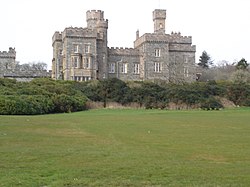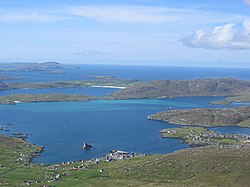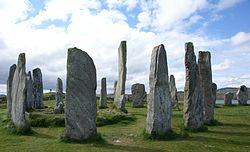Outer Hebrides
The Outer Hebrides, often called the Western Isles,[4] make up an island chain off the west coast of Scotland. It is also a parliamentary constituency. The northern island is Lewis and Harris. South of Lewis and Harris is a series of islands, such as South Uist, Benbecula and North Uist. The Outer Herides includes a number of even smaller islands.
| Outer Hebrides | |
|---|---|
| Location | |
| OS grid reference: | NB426340 |
| Coordinates: | 57°46′N 7°01′W / 57.76°N 7.02°WCoordinates: 57°46′N 7°01′W / 57.76°N 7.02°W |
| Names | |
| Gaelic name: | |
| Meaning of name: | Western Isles |
| Area and Summit | |
| Area: | [convert: needs a number][1] |
| Highest elevation: | Clisham 799 m (2,621 ft)[2] |
| Population | |
| Population (2001): | [3] |
| Main settlement: | Stornoway |
| Groupings | |
| Island Group: | {{{island group}}} |
| Local Authority: | Comhairle nan Eilean Siar |
| Scotland File:Lymphad3.svg | |
| References: | |
The isles form part of the Hebrides, and are separated from the Scottish mainland and from the Inner Hebrides by the stormy waters of the Minch, the Little Minch and the Sea of the Hebrides.
Formerly the dominant language of the Islands, Scottish Gaelic remains spoken even though it has now been largely supplanted by English in some parts.
Sea transport is crucial and a variety of ferry services operate between the islands and to mainland Britain.
History
The Western Isles became part of the Suðreyjar kingdom of the Norse, who ruled for over 400 years until sovereignty was transferred to Scotland by the Treaty of Perth in 1266. Control of the islands was then held by clan chiefs.
Geology & geography
Most of the islands have a bedrock formed from ancient metamorphic rocks and the climate is mild and oceanic. The Gulf Stream runs nearby. The 15 inhabited islands have a total population of about 26,500 and there are more than 50 substantial uninhabited islands.
Flora and fauna
Much of the archipelago is a protected habitat including both the islands and the surrounding waters. There are 53 Sites of Special Scientific Interest (SSSI) of which the largest are Loch an Duin, North Uist at 15,100 hectares (37,000 acres) and North Harris, which is 12,700 hectares (31,000 acres) in extent.[5][6]
Loch Druidibeg on South Uist is a National Nature Reserve owned and managed by Scottish Natural Heritage. The reserve covers 1,677 hectares across the whole range of local habitats.[7]
Outer Hebrides Media
Nicolson's Leap on the east coast of South Uist. In the background are Beinn Mhòr at left, and Hecla on the right.
Bàgh Mòr, Grimsay
Geological map of the Hebridean terrane
The "Old Boy" — the gneiss cliffs of Sloc na Bèiste, Barra Head, the southernmost point of the Outer Hebrides
Other websites
Historical footnote: Many websites of the Outer Hebrides derive content from the Eolas Virtual Hebrides, website. Eolas went bankrupt in 2000 and the Eolas TV company became MacTV. The web design team became Reefnet and the content has largely found a home on GlobalGuide.Org.
Sites deriving partly from the original Virtual Hebrides
- Hebrides.com Photographic website from ex-Eolas Sam Maynard
- Global Guide Hebrides Archived 2007-10-01 at the Wayback Machine Content website from ex-Eolas Scott Hatton
- www.visithebrides.com Western Isles Tourist Board site from Reefnet
- Virtual Hebrides.com Content from the VH which went its own way and became Virtual Scotland.
- hebrides.ca Home of the Quebec-Hebridean Scots who were cleared from Lewis to Quebec 1838-1920's
Other Outer Hebrides websites
 Outer Hebrides travel guide from Wikivoyage
Outer Hebrides travel guide from Wikivoyage- Stornoway Port Authority Archived 2023-06-01 at the Wayback Machine
- Comhairle nan Eilean Siar
- 2001 Census Results for the Outer Hebrides Archived 2007-03-10 at the Wayback Machine
- Visitor's guide to Stornoway Archived 2007-12-13 at the Wayback Machine
- Hebridean-Life.com - a Guide to Living in the Outer Hebrides Archived 2008-12-24 at the Wayback Machine
Notes
- ↑ "Standard Area Measurements - Local Authorities - Dec 2010 (SAM_LAD_DEC_2010_UK)". UK Standard Area Measurements (SAM). Office for National Statistics. 31 December 2010. Retrieved 1 October 2011.
- ↑ Thompson (1968) p. 14
- ↑ "Table 8a Mid-2011 Population Estimates: Selected age groups for local authorities in England and Wales; estimated resident population;". Population Estimates for England and Wales, Mid 2011 (Census Based). Office for National Statistics. 2012-09-25. Retrieved 2012-11-22.
- ↑ Although officially known by the Gaelic name, Na h-Eileanan Siar, this name is not understood in English.
- ↑ "Western Isles transitional programme strategy" Archived 2011-06-29 at the Wayback Machine Comhairle nan Eilean Siar. Retrieved 19 May 2010.
- ↑ Rotary Club (1995) p. 10
- ↑ "Loch Druidibeg National Nature Reserve: where opposites meet". Archived 2016-03-03 at the Wayback Machine (pdf) SNH. Retrieved 29 July 2007.








